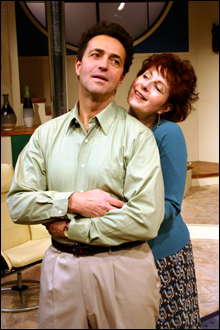 The word tragedy means “goat song” in ancient Greek, and indeed, the protagonist of Edward Albee’s The Goat or, Who Is Sylvia? is making beautiful music with a mistress of the caprine persuasion. But Albee is up to more in his 2002 Tony-winning play, which is subtitled “Notes Toward a Definition of Tragedy,” than chronicling the perversely funny, family-shattering results of a liaison with livestock. The cryptic semanticist who first entered the Strindbergian arena of marital blood sport in Who’s Afraid of Virginia Woolf? is back in the ring, this time going beyond the coy allegory suggested by the names George and Martha to imagine a contemporary absurdist tragedy in the manner of the ancients — in which a prominent individual and his family are brought low by a fated, fatal flaw. You don’t believe every word of The Goat, and it certainly has its share of arch, allusive jokes. But Albee achieves his goal: to force the audience to reconsider the borders of what is acceptable, much as Oedipus’s inadvertent forays into the unspeakable did, stirring pity and horror in the citizens of Athens. That the play is hilarious as well as wrenching is just gravy to the meat of The Goat, a 100-minute drawing-room juggernaut that’s being served with blood, guts, and waspish flair in its Boston premiere at Lyric Stage Company of Boston (through March 18).
The word tragedy means “goat song” in ancient Greek, and indeed, the protagonist of Edward Albee’s The Goat or, Who Is Sylvia? is making beautiful music with a mistress of the caprine persuasion. But Albee is up to more in his 2002 Tony-winning play, which is subtitled “Notes Toward a Definition of Tragedy,” than chronicling the perversely funny, family-shattering results of a liaison with livestock. The cryptic semanticist who first entered the Strindbergian arena of marital blood sport in Who’s Afraid of Virginia Woolf? is back in the ring, this time going beyond the coy allegory suggested by the names George and Martha to imagine a contemporary absurdist tragedy in the manner of the ancients — in which a prominent individual and his family are brought low by a fated, fatal flaw. You don’t believe every word of The Goat, and it certainly has its share of arch, allusive jokes. But Albee achieves his goal: to force the audience to reconsider the borders of what is acceptable, much as Oedipus’s inadvertent forays into the unspeakable did, stirring pity and horror in the citizens of Athens. That the play is hilarious as well as wrenching is just gravy to the meat of The Goat, a 100-minute drawing-room juggernaut that’s being served with blood, guts, and waspish flair in its Boston premiere at Lyric Stage Company of Boston (through March 18).
Martin is a successful architect who has just won the prestigious Pritzker Prize, scored a $200 billion commission to design a “dream city of the future” in the Middle West, and turned 50. He is happily married to Stevie, with whom he shares a satisfying sexual relationship and a sly sense of humor. And they are the parents of worldly 17-year-old Billy, whose recent announcement that he’s gay they are dealing with as the right-thinking liberal intellectuals they are. But when Martin’s old buddy Ross comes to interview him for a television show called People Who Matter, Martin is distracted. And Ross, boasting a devilish grin and a we’re-all-boys-together air, extracts from his friend the confidence that, yes, for the first time in his marriage, he is being “physically untrue.” Sheepishly, Martin rummages in his wallet for a photo and hands it over to an astonished Ross, who at once discerns that Sylvia, whose spell Martin has come under while on an outing to look at country property, “IS A GOAT!”

What Ross would actually do in such a situation (say, demand that Martin get therapy) he doesn’t do here. He writes a pompous, squealing letter to Stevie. And as in the cautionary tales of the ancients, the coming of an unsavory secret into the light brings with it calamity. Like Albee’s recent prequel to The Zoo Story, Homelife, The Goat can get too linguistically clever by half, and Martin never adequately explains his irresistible attraction to Sylvia except to describe it as a sort of “ecstasy” triggered by the animal’s “amazing” eyes. But the trick of the play is that it’s at once caustically funny and herculeanly painful — a combination for which you could not do better than Paula Plum, who has the chops for Noël Coward and Euripides alike. The play’s scathing middle scene, in which Stevie splinters a lot of objets d’art while attempting to convey to Martin how irrevocably he has made a Humpty Dumpty of their lives, stretches the actress to the limits of sarcasm and heartbreak, and she proves supple.
More astonishing still, since the actor originally cast as Martin withdrew a week before opening and Stephen Schnetzer, who had understudied the role on Broadway and played it at Arena Stage, had to be plugged into the hole, Plum does not exercise alone. Schnetzer fits seamlessly into Spiro Veloudos’s committed production, which unfolds on a gamely if unconvincingly evoked architect’s-living-room set by Brynna C. Bloomfield. If his Martin is perhaps too befuddled early on, he brings raw honesty to both the man’s occasionally flaring forcefulness and his mounting, boyish anguish. Martin seems to tell the tale of his erotic downfall more to the audience than to Stevie, but, hey, her anger and revulsion are pretty scary. Richard Snee captures the slickness of pseudo-moralist Judas figure Ross, who thinks nothing can’t be taped up with a little PR. And recent BU grad Tasso Feldman nails both Billy’s precociousness and the fear the crisis evokes in the heretofore cosseted adolescent, who adds an abrupt, possibly unnecessary moment of homosexual incest to the pot, just in case our tolerance hasn’t been adequately tested by dad’s tender foray into country matters.